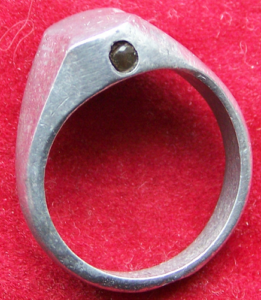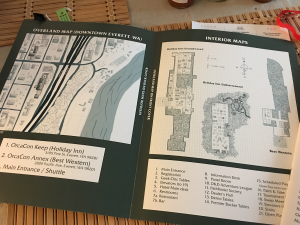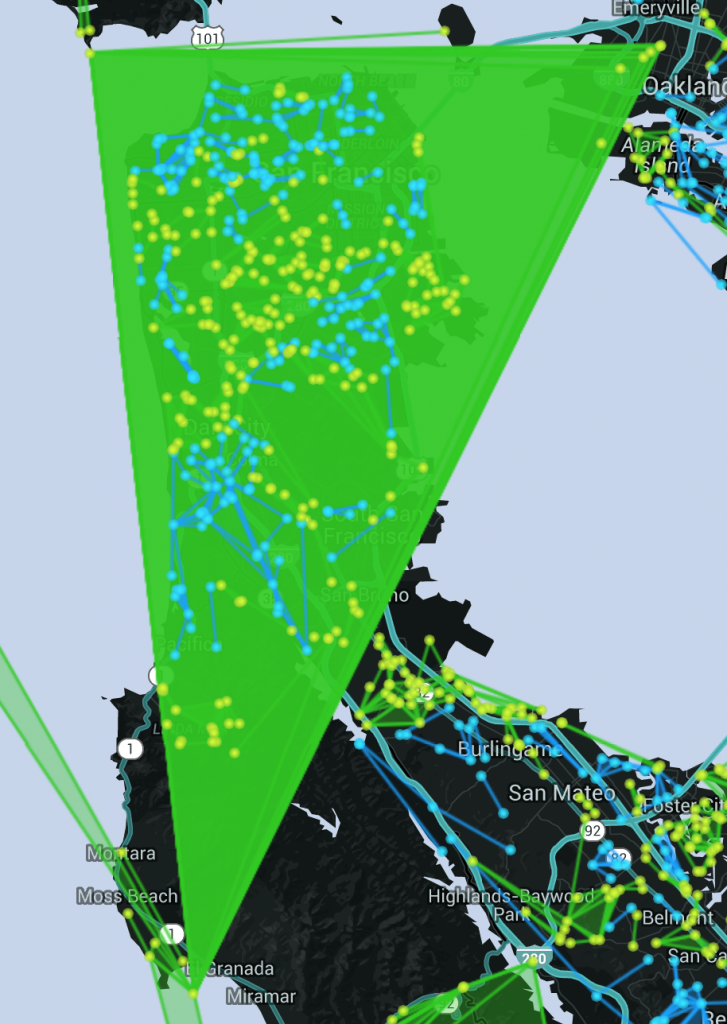 In 1857, a French photographer named René Dagron combined the hot new fad of microphotography and a 50 year old magnifying device called a Stanhope lens to come up with a simple inexpensive way of embedding tiny photographs into a wide range of gewgaws. Stanhope lenses are small enough to embed within rings, watch keys, pocket knives, charms, and so on. Dagron was also an entrepreneur: he ran a mail order business selling the things. Since they were cheap enough to market as souvenirs, they became fairly common fairly quickly.
In 1857, a French photographer named René Dagron combined the hot new fad of microphotography and a 50 year old magnifying device called a Stanhope lens to come up with a simple inexpensive way of embedding tiny photographs into a wide range of gewgaws. Stanhope lenses are small enough to embed within rings, watch keys, pocket knives, charms, and so on. Dagron was also an entrepreneur: he ran a mail order business selling the things. Since they were cheap enough to market as souvenirs, they became fairly common fairly quickly.
The images are remarkably clear and detailed despite their tiny size. One could, hypothetically, put quite a bit of text in one of these. During the Franco-Prussian War of 1870, Dagron refined his microphotography process to generate carrier pigeon messages. This usage didn’t require Stanhope lenses in reality. Who knows what might have happened in a slightly different time stream?
The fad was mostly over by World War I, but there are plenty of the things floating around during the 1930s era of Trail of Cthulhu. If you’re running a Night’s Black Agents game, you’ll be happy to know that Stanhopes still turn up all the time in the wild in 2018. Also fun: it’s not obvious when an object has a Stanhope embedded within it. The photographs are 1/10th of an inch in diameter and a mere quarter of an inch long; modern collectors often miss the presence of a Stanhope. This makes them awesome as unexpected surprises for an investigatory game.
Based on a few hours of Web surfing, I can’t find any evidence that anyone put a Stanhope into a book spine — but someone really should have. This is an easy Bookhounds of London hook. The book itself is something anodyne and unremarkable, but the spine contains images of a horrible crime. Who took them? Why were they preserved in this manner? What’s casting that terrifying shadow in the background?
For a conventional Trail of Cthulhu game, stick the same images in a more traditional Stanhope carrier. Want something more outré? Consider the pocket knife with a small glass aperture at one end. If you look into the glass aperture, what looks back out at you? The Stanhope brooch is the only path this creature has to reach the outer world, and it’s been trapped in there for decades. It will not be grateful to you.
Wait: this Stanhope shows a moving picture. Something strange. It’s the Dreamlands, or Carcosa if you’re into Hastur.
For Night’s Black Agents, a Stanhope would be a great way to introduce a picture of a prominent NPC. Who, of course, looks the same in the picture as he does now. Most photographic evidence of his earlier life was destroyed, but Stanhopes are easy to miss. Or you can go straight espionage, and have one contain microfilm as an information carrier. Also, since we’re talking vampires, I should note that there were plenty of Stanhopes built into crosses. One common cross had seven Stanhopes in it, each one depicting one of the Seven Sorrows of the Virgin Mary. Any vampire game ought to be able to do something useful with that.
Skill-wise, a Trail of Cthulhu character needs Art History or a Evidence Collection spend to notice one of these things. Craft could also work given the right specialty. Bookhounds could use Document Analysis. For Night’s Black Agents, a Notice spend can stand in for Evidence Collection. Art History remains preferable — give those PCs some payoff for all those years spent in museums.
There’s a book on these, which looks really interesting but I’m not sure about giving into temptation. It has pictures, though. Tempting.



 This is what I did with my evening. To be precise, I had a small part in creating the conditions that made this possible. We did not execute perfectly for various and sundry reasons, but that’s what the human ability to learn and improve is for.
This is what I did with my evening. To be precise, I had a small part in creating the conditions that made this possible. We did not execute perfectly for various and sundry reasons, but that’s what the human ability to learn and improve is for.